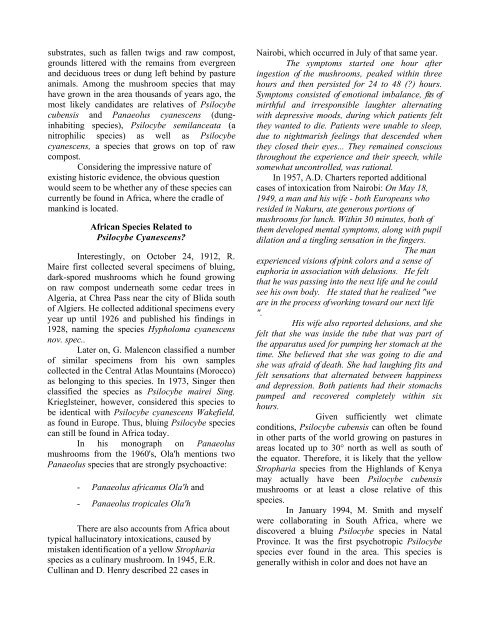Jochen Gartz - Magic Mushrooms Around the ... - preterhuman.net
Jochen Gartz - Magic Mushrooms Around the ... - preterhuman.net
Jochen Gartz - Magic Mushrooms Around the ... - preterhuman.net
You also want an ePaper? Increase the reach of your titles
YUMPU automatically turns print PDFs into web optimized ePapers that Google loves.
substrates, such as fallen twigs and raw compost,<br />
grounds littered with <strong>the</strong> remains from evergreen<br />
and deciduous trees or dung left behind by pasture<br />
animals. Among <strong>the</strong> mushroom species that may<br />
have grown in <strong>the</strong> area thousands of years ago, <strong>the</strong><br />
most likely candidates are relatives of Psilocybe<br />
cubensis and Panaeolus cyanescens (dunginhabiting<br />
species), Psilocybe semilanceata (a<br />
nitrophilic species) as well as Psilocybe<br />
cyanescens, a species that grows on top of raw<br />
compost.<br />
Considering <strong>the</strong> impressive nature of<br />
existing historic evidence, <strong>the</strong> obvious question<br />
would seem to be whe<strong>the</strong>r any of <strong>the</strong>se species can<br />
currently be found in Africa, where <strong>the</strong> cradle of<br />
mankind is located.<br />
African Species Related to<br />
Psilocybe Cyanescens<br />
Interestingly, on October 24, 1912, R.<br />
Maire first collected several specimens of bluing,<br />
dark-spored mushrooms which he found growing<br />
on raw compost underneath some cedar trees in<br />
Algeria, at Chrea Pass near <strong>the</strong> city of Blida south<br />
of Algiers. He collected additional specimens every<br />
year up until 1926 and published his findings in<br />
1928, naming <strong>the</strong> species Hypholoma cyanescens<br />
nov. spec..<br />
Later on, G. Malencon classified a number<br />
of similar specimens from his own samples<br />
collected in <strong>the</strong> Central Atlas Mountains (Morocco)<br />
as belonging to this species. In 1973, Singer <strong>the</strong>n<br />
classified <strong>the</strong> species as Psilocybe mairei Sing.<br />
Krieglsteiner, however, considered this species to<br />
be identical with Psilocybe cyanescens Wakefield,<br />
as found in Europe. Thus, bluing Psilocybe species<br />
can still be found in Africa today.<br />
In his monograph on Panaeolus<br />
mushrooms from <strong>the</strong> 1960's, Ola'h mentions two<br />
Panaeolus species that are strongly psychoactive:<br />
- Panaeolus africanus Ola'h and<br />
- Panaeolus tropicales Ola'h<br />
There are also accounts from Africa about<br />
typical hallucinatory intoxications, caused by<br />
mistaken identification of a yellow Stropharia<br />
species as a culinary mushroom. In 1945, E.R.<br />
Cullinan and D. Henry described 22 cases in<br />
Nairobi, which occurred in July of that same year.<br />
The symptoms started one hour after<br />
ingestion of <strong>the</strong> mushrooms, peaked within three<br />
hours and <strong>the</strong>n persisted for 24 to 48 () hours.<br />
Symptoms consisted of emotional imbalance, fits of<br />
mirthful and irresponsible laughter alternating<br />
with depressive moods, during which patients felt<br />
<strong>the</strong>y wanted to die. Patients were unable to sleep,<br />
due to nightmarish feelings that descended when<br />
<strong>the</strong>y closed <strong>the</strong>ir eyes... They remained conscious<br />
throughout <strong>the</strong> experience and <strong>the</strong>ir speech, while<br />
somewhat uncontrolled, was rational.<br />
In 1957, A.D. Charters reported additional<br />
cases of intoxication from Nairobi: On May 18,<br />
1949, a man and his wife - both Europeans who<br />
resided in Nakuru, ate generous portions of<br />
mushrooms for lunch. Within 30 minutes, both of<br />
<strong>the</strong>m developed mental symptoms, along with pupil<br />
dilation and a tingling sensation in <strong>the</strong> fingers.<br />
The man<br />
experienced visions of pink colors and a sense of<br />
euphoria in association with delusions. He felt<br />
that he was passing into <strong>the</strong> next life and he could<br />
see his own body. He stated that he realized "we<br />
are in <strong>the</strong> process of working toward our next life<br />
".<br />
His wife also reported delusions, and she<br />
felt that she was inside <strong>the</strong> tube that was part of<br />
<strong>the</strong> apparatus used for pumping her stomach at <strong>the</strong><br />
time. She believed that she was going to die and<br />
she was afraid of death. She had laughing fits and<br />
felt sensations that alternated between happiness<br />
and depression. Both patients had <strong>the</strong>ir stomachs<br />
pumped and recovered completely within six<br />
hours.<br />
Given sufficiently wet climate<br />
conditions, Psilocybe cubensis can often be found<br />
in o<strong>the</strong>r parts of <strong>the</strong> world growing on pastures in<br />
areas located up to 30° north as well as south of<br />
<strong>the</strong> equator. Therefore, it is likely that <strong>the</strong> yellow<br />
Stropharia species from <strong>the</strong> Highlands of Kenya<br />
may actually have been Psilocybe cubensis<br />
mushrooms or at least a close relative of this<br />
species.<br />
In January 1994, M. Smith and myself<br />
were collaborating in South Africa, where we<br />
discovered a bluing Psilocybe species in Natal<br />
Province. It was <strong>the</strong> first psychotropic Psilocybe<br />
species ever found in <strong>the</strong> area. This species is<br />
generally withish in color and does not have an








![The Big Lie 9-11 and Government Complicity in Mass Murder [PDF]](https://img.yumpu.com/50957077/1/190x245/the-big-lie-9-11-and-government-complicity-in-mass-murder-pdf.jpg?quality=85)








